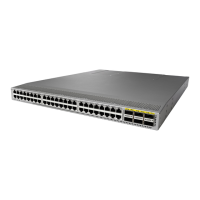Send document comments to nexus3k-docfeedback@cisco.com
12-5
Cisco Nexus 3000 Series NX-OS Unicast Routing Configuration Guide, NX-OS Release5.0(3)U1(1)
Chapter 12 Configuring HSRP
Information About HSRP
Figure 12-2 HSRP Load Sharing
Figure 12-2 shows two routers A and B and two HSRP groups. Router A is the active router for group A
but is the standby router for group B. Similarly, router B is the active router for group B and the standby
router for group A. If both routers remain active, HSRP load balances the traffic from the hosts across
both routers. If either router fails, the remaining router continues to process traffic for both hosts.
Object Tracking and HSRP
You can use object tracking to modify the priority of an HSRP interface based on the operational state
of another interface. Object tracking allows you to route to a standby router if the interface to the main
network fails.
Two objects that you can track are the line protocol state of an interface or the reachability of an IP route.
If the specified object goes down, Cisco NX-OS reduces the HSRP priority by the configured amount.
For more information, see the “Configuring HSRP Object Tracking” section on page 12-12.
Virtualization Support
HSRP supports Virtual Routing and Forwarding instances (VRFs). By default, Cisco NX-OS places you
in the default VRF unless you specifically configure another VRF.
If you change the VRF membership of an interface, Cisco NX-OS removes all Layer 3 configuration,
including HSRP.
For more information, see Chapter 9, “Configuring Layer 3 Virtualization.”
Router B
Router A
Standby
Standby
Active
Active
User Group A
Default Gateway = 192.0.2.1
User Group B
Default Gateway = 192.0.2.2
Group A = 192.0.2.1
Group B = 192.0.2.2
185059

